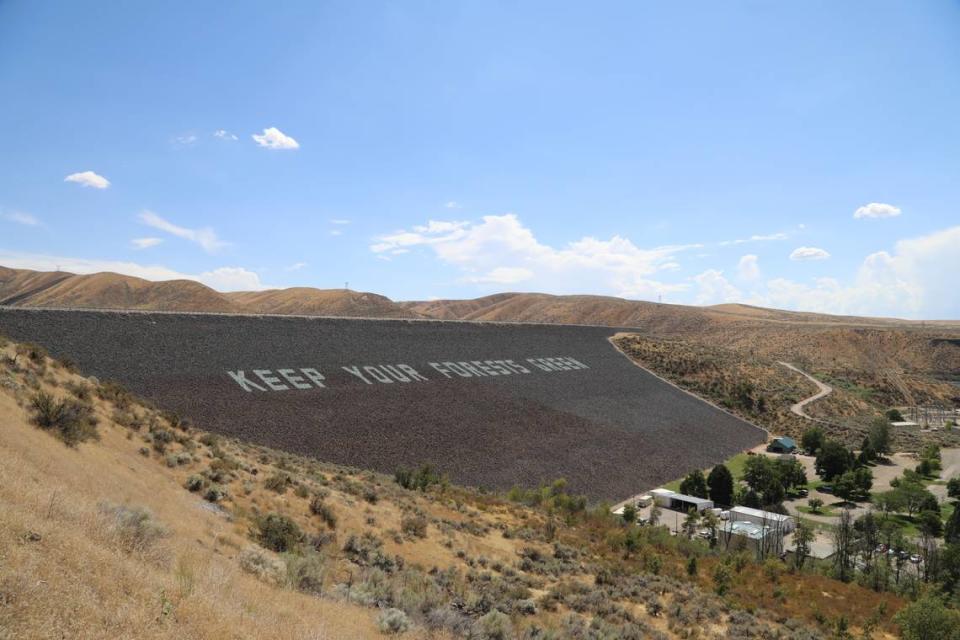Idaho drought caused early water shutoffs last summer. What’s the outlook this year?
It was only a year ago that drought forced irrigation districts in Southwest Idaho to cut off water supply early and ask Treasure Valley residents to let their lawns turn brown.
The outlook for 2022 as summer inches toward fall is much better.
Because of this year’s cooler, wetter spring, most of Southwest Idaho is experiencing less severe drought or no drought at all, said David Hoekema, a hydrologist for the Idaho Department of Water Resources.
Hoekema told the Idaho Statesman that the spring weather was essential and “helped pull all of Idaho” out of tougher conditions.
The U.S. Drought Monitor shows Ada County is experiencing abnormally dry conditions, which Hoekema said do not qualify as a full-blown drought. Most of Elmore County and Canyon County are experiencing these conditions as well.
Owyhee County is divided. Parts of it are experiencing either abnormally dry, moderate drought or severe drought conditions. A small portion of southeast Owyhee County is in extreme drought.
This time last year, all of Idaho was in a drought, and much of Southwest Idaho was experiencing severe drought, according to the monitor’s archives. This caused more aggressive measures to be taken with irrigation water. The Pioneer, Nampa-Meridian and Boise-Kuna districts all shut off water on Sept. 15.
Bob Carter, the project manager for the Boise Project Board of Control, said a typical shutoff date is in mid-October.
The Boise Project Board of Control oversees five irrigation districts — Nampa-Meridian, Boise-Kuna and New York among them — and Carter said it has not yet decided what the shutoff dates will be. He told the Statesman that if they are slightly earlier than normal this year, that would be done to conserve water for next year, because “we’re trying to be prepared.”
Hoekema said he does not anticipate early shutoffs.
Experts expected drought to continue this summer
Hoekema said the 2022 outlook has been a pleasant surprise, since many experts were predicting another drought year after a lackluster snowpack last winter. He said recovering from a drought without a strong snowpack is “really rare” but “not unheard of.”
The Boise River has been flowing at only 80% capacity this summer, which Hoekema said was another obstacle to overcome in Southwest Idaho’s recovery.
“At the beginning of the season, we started out with the same conditions,” Carter said. “We were in a drought, and the reservoir was way low, so a lot of our patrons planned accordingly, and they were expecting a short season.”
David Whitwood was one of those patrons. He works as a plant breeder for Crookham Seed Company, a family-owned seed wholesaler in Caldwell. The company grows and exports onion, popcorn and sweet corn seeds.
“April, May, when the forecast we had for irrigation was not good, we were looking at leaving a lot of ground fallow,” Whitwood told the Statesman.
But spring rains and cooler temperatures helped change things. Hoekema said the Boise Basin saw 154% of normal rainfall in the spring. Cooler than normal temperatures helped delay the melting of the snowpack and allowed the area to recover from drought. The Boise and Payette rivers both will finish the season with some water to spare, he said.
“That means we have a little extra water in the reservoir system as an insurance policy against next year,” Hoekema said.

Irrigation districts still advise cautious water usage going into next year
Carter said that even though conditions have been better than predicted, he and the board are looking ahead. They will decide at their September meeting when the shutoff dates will be.
“We’d like to conserve some water for next year because we don’t know what the future holds for this winter,” he said. “We have the ability to carry over some water in Anderson Ranch (Reservoir), so we’re looking at the future.”
Carter said that even in good years, the board of control is cautious.
“We’re always trying to conserve water and to carry over water in the event that the precipitation is lower than normal,” Carter said. “We’ve been practicing good stewardship of the water for years.”
Hoekema said he recommends that Treasure Valley residents try to use less water to irrigate their lawns and gardens, but the lion’s share of water from the Boise River reservoir system goes to agriculture. He said he would not be surprised if some farmers voluntarily end irrigating a little early this season to conserve.
Treasure Valley requires irrigation, even without drought
Whitwood said Crookham is making efforts to conserve water by using drip irrigation, being more conscious of spillage and “working better with the water that we have.”
But he pointed out that farmers have to irrigate their fields every year. Drought or no drought, agriculture in the Treasure Valley cannot survive without irrigation water.
Addressing the history of water usage in the Boise River valley, Hoekema said that when settlers first arrived, they relied on a system of canals to allocate water. But the river usually began to reach its base level by July, which limited agriculture in the region.
Residents then began building a system of dams and reservoirs that could capture water and release it throughout the later part of the summer, expanding the Treasure Valley’s agriculture possibilities.
The valley still relies on drafting water from its reservoirs, but that drafting began significantly later this year than in the past.
“Last year they started drafting about April 15,” Hoekema said. “This year they didn’t seriously start drafting the reservoir until the end of June.”
This strategy should help the region carry over more water into next year. Hoekema said that’s critical because there is a “high probability” of weak snowpack again this winter.
“It’s good to conserve as much as possible so that we can have the maximum amount of carryover in the system in case we enter into a drought next year,” said Hoekema.

